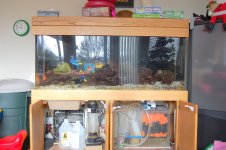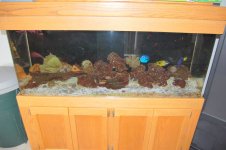opticjim":9ofjseri said:
ok agreed not too much live rock, now i have a big sump so are bio balls the best media and if not what does belong in there.
If I have learned
anything in the 20+ years I've been involved in the aquarium hobby/trade, it's this -- If it ain't broke, DON'T fix it!
I am thinking to remove small amounts of balls each week and replace with ??.
Bioballs were the choice of the day because they don't allow a lot of detritus to build up, offered a large surface area for nitrifying bacteria to reside, and allowed a large water surface area which allows for excellent oxygen/carbon dioxide exchange. This exchange
only occurs at water surfaces, making surface agitation of your tank and sump important for the best O2 saturation possible.
You were talking about replacing the crushed coral with live sand, that would do it, as would the addition of live rock, I would add about 1lb./gallon at this point. (Sorry, had to edit to add that bit.)
If i use rock do i submerge it of does or water drip over it?
Put the rock in any container fully submerged. Whether in the sump or in the tank itself doesn't really matter, although if nice looking rock it could make for nice aquascaping.
also is the large sponge filter I have neccasarry, I have been told the protien skimmer will take care of all of this ( not sure about that)
A protein skimmer, also known as foam fractionation, cannot really adequately accomplish mechanical filtration. The sponge filter does two things -- mechanical filtration (removal of particulates), and also serves as a residence for the aforementioned nitrifying bacteria. Passing the water through or over some sort of mechanical filtration is a good idea for your particular set-up, in my experience.
do you use and other media in your tank? charcol?, denitrate,?purigen? I have use all of these but not sure of there effectiveness. I am also runnig a phosban filter from ?
It really depends on your tank, there are really too many variables. All the filtrants you mention are chemical filtrants. If you need, for instance, something like "denitrate" (a product I'm not familiar with), then I would surmise you have high nitrate levels. This can be addressed in many ways; the addition and good utilization of a refugium where you would place macroalgae that would then uptake nitrate, as well as provide a home for the various "pods" (pick a pod, iso, arthro, cope, etcetera) that many fish like and others rely upon for nutrition would be my first and favorite choice.
Foam fractionation, assuming your skimmer is working well, is another means by which one can control nitrate level.
It also matters what quality your source water (assuming you mix your saltwater and don't use natural seawater), if it's already high in nitrate then you're going to be hard pressed to correct such a problem by water changes. (Many municipalities allow nitrate levels as high as 40ppm, for instance.) Phosphorous would be another problem if it is present in your source water that one might use a product such as Phosban to help control.
3 fishes or something it is hidden from the picture behind the center door
I don't know what that means or what the issue is.
The wierd part is this tank has been really solid for 5 years or so no dead fish
That's not weird, it means that the system is stable and meets the fishes' needs. If they're not diseased and are growing, then it means that they're thriving. In other words, if it ain't broke, don't fix it. Or, at the very least, be
very careful about what changes you make.
At this point, looking at the tank and knowing that you're not experiencing deaths or illness, I say maybe add some live rock to the tank. If the tank's nitrate level is high or you're seeing stuff like lateral line disease, then there are indeed husbandry issues that should be addressed. Water changes tend to be a good thing, as long as the mix water is well aged and aerated.
Just remember that by removing the Bioballs you're removing THE most important element of your filtration -- biological (a.k.a. nitrifying) filtration. That is the conversion (oxidation) of ammonia (a.k.a. nitrogenous wastes) into less toxic substances, first nitrite (which is still rather toxic), then to nitrate (less toxic, but can be in high enough concentrations). The final piece is complete removal of nitrate, but this is only accomplished biologically via DEnitrification and that is an anaerobic process (it occurs deep within live rock, for instance, which is why Mr. X keeps mentioning it).
Is this stuff making sense for you? If not, there is a bit of recommended reading you might wish to avail yourself of in order to help understand the process. However, that being said, some of the best wet thumbs I've ever known never read a thing.
Go slowly, whatever you do, ok? I'd hate for you to end up killing off your fish for making changes all these people might insist you
have to do simply because it is
current conventional wisdom.







